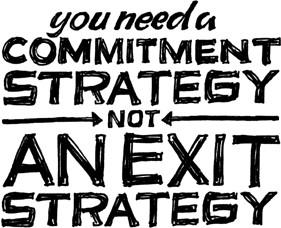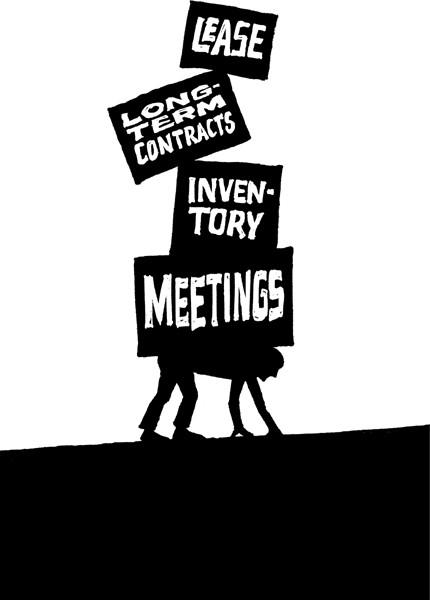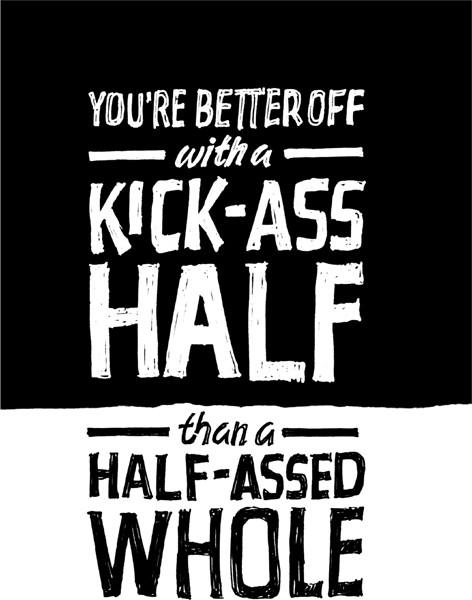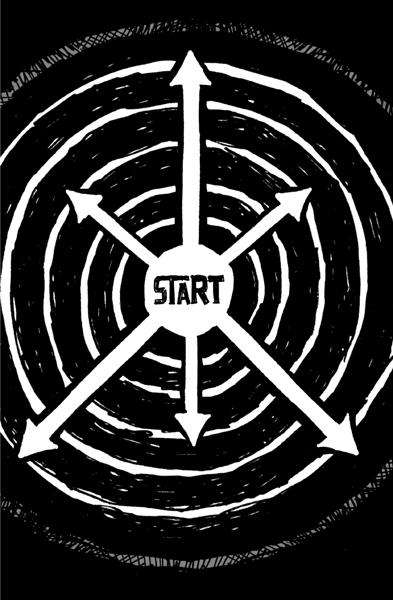Rework (5 page)
Authors: Jason Fried,David Heinemeier Hansson
Tags: #Business & Economics, #General

Do you really need to build a factory or can you hire someone else to manufacture your products?
Do you really need an accountant or can you use Quicken and do it yourself?
Do you really need an IT department or can you outsource it?
Do you really need a full-time support person or can you handle inquiries on your own?
Do you really need to open a retail store or can you sell your product online?
Do you really need fancy business cards, letterhead, and brochures or can you forego that stuff?
You get the point. Maybe eventually you’ll need to go the bigger, more expensive route, but not right now.
There’s nothing wrong with being frugal. When we launched our first product, we did it on the cheap. We didn’t get our own office; we shared space with another company. We didn’t get a bank of servers; we had only one. We didn’t advertise; we promoted by sharing our experiences online. We didn’t hire someone to answer customer e-mails; the company founder answered them himself. And everything worked out just fine.
Great companies start in garages all the time. Yours can too.

Start a business, not a startup
Ah, the startup. It’s a special breed of company that gets a lot of attention (especially in the tech world).
The start up is a magical place. It’s a place where expenses are someone else’s problem. It’s a place where that pesky thing called revenue is never an issue. It’s a place where you can spend other people’s money until you figure out a way to make your own. It’s a place where the laws of business physics don’t apply.
The problem with this magical place is it’s a fairy tale. The truth is every business, new or old, is governed by the same set of market forces and economic rules. Revenue in, expenses out. Turn a profit or wind up gone.
Startups try to ignore this reality. They are run by people trying to postpone the inevitable, i.e., that moment when their business has to grow up, turn a profit, and be a real, sustainable business.
Anyone who takes a “we’ll figure out how to profit in the future” attitude to business is being ridiculous. That’s like building a rocket ship but starting off by saying, “Let’s pretend gravity doesn’t exist.”
A business without a path to profit isn’t a business, it’s a hobby
.
So don’t use the idea of a startup as a crutch. Instead, start an actual business. Actual businesses have to deal with actual things like bills and payroll. Actual businesses worry about profit from day one. Actual businesses don’t mask deep problems by saying, “It’s OK, we’re a startup.” Act like an actual business and you’ll have a much better shot at succeeding.

Building to flip is building to flop
Another thing you hear a lot: “What’s your exit strategy?” You hear it even when you’re just beginning. What is it with people who can’t even start building something without knowing how they’re going to leave it? What’s the hurry? Your priorities are out of whack if you’re thinking about getting out before you even dive in.
Would you go into a relationship planning the breakup? Would you write the prenup on a first date? Would you meet with a divorce lawyer the morning of your wedding? That would be ridiculous, right?
You need a commitment strategy, not an exit strategy. You should be thinking about how to make your project grow and succeed, not how you’re going to jump ship. If your whole strategy is based on leaving, chances are you won’t get far in the first place.
You see so many aspiring businesspeople pinning their hopes on selling out. But the odds of getting acquired are so tiny. There’s only a slim chance that some big suitor will come along and make it all worthwhile. Maybe 1 in 1,000? Or 1 in 10,000?
Plus, when you build a company with the intention of being acquired, you emphasize the wrong things. Instead of focusing on getting customers to love you, you worry about who’s going to buy you. That’s the wrong thing to obsess over.
And let’s say you ignore this advice and do pull off a flip. You build your business, sell it, and get a nice payday. Then what? Move to an island and sip piña coladas all day? Will that really satisfy you? Will money alone truly make you happy? Are you sure you’ll like that more than running a business you actually enjoy and believe in?
That’s why you often hear about business owners who sell out, retire for six months, and then get back in the game. They miss the thing they gave away. And usually, they’re back with a business that isn’t nearly as good as their first.
Don’t be that guy. If you do manage to get a good thing going, keep it going. Good things don’t come around that often. Don’t let your business be the one that got away.

Less mass
Embrace the idea of having less mass. Right now, you’re the smallest, the leanest, and the fastest you’ll ever be. From here on out, you’ll start accumulating mass. And the more massive an object, the more energy required to change its direction. It’s as true in the business world as it is in the physical world. Mass is increased by …
Long-term contracts
Excess staff
Permanent decisions
Meetings
Thick process
Inventory (physical or mental)
Hardware, software, and technology lock-ins
Long-term road maps
Office politics
Avoid these things whenever you can. That way, you’ll be able to change direction easily. The more expensive it is to make a change, the less likely you are to make it.
Huge organizations can take years to pivot. They talk instead of act. They meet instead of do. But if you keep your mass low, you can quickly change anything: your entire business model, product, feature set, and/or marketing message. You can make mistakes and fix them quickly. You can change your priorities, product mix, or focus. And most important, you can change your mind.
*
Jim Rutenberg, “Clinton Finds Way to Play Along with Drudge,”
New York Times
, Oct. 22, 2007.
*
“Fascinating Facts About James Dyson, Inventor of the Dyson Vacuum Cleaner in 1978,”
www.ideafinder.com/history/inventors/dyson.htm
†
Russ Mitchell, “The Beat Goes On,” CBS News,
Sunday Morning
, Mar. 29, 2009,
www.tinyurl.com/cd8gjq
‡
Eric Ransdell, “The Nike Story? Just Tell It!”
Fast Company
, Dec. 19, 2007,
www.fastcompany.com/magazine/31/nike.html
*
“Mary Kay Ash: Mary Kay Cosmetics,”
Journal of Business Leadership
1, no. 1 (Spring 1988); American National Business Hall of Fame,
www.anbhf.org/laureates/mkash.html
*
“Stanley Kubrick
—Biography,” IMDB,
www.imdb.com/name/nm00004o/bio
*
Mission, Enterprise Rent-a-Car,
http://aboutus.enterprise.com/who_we_are/mission.html
CHAPTER
PROGRESS

Embrace constraints
“I don’t have enough time/money/people/experience.” Stop whining. Less is a good thing. Constraints are advantages in disguise. Limited resources force you to make do with what you’ve got. There’s no room for waste. And that forces you to be creative.
Ever seen the weapons prisoners make out of soap or a spoon? They make do with what they’ve got. Now we’re not saying you should go out and shank somebody—but get creative and you’ll be amazed at what you can make with just a little.
Writers use constraints to force creativity all the time. Shakespeare reveled in the limitations of sonnets (fourteen-line lyric poems in iambic pentameter with a specific rhyme scheme). Haiku and limericks also have strict rules that lead to creative results. Writers like Ernest Hemingway and Raymond Carver found that forcing themselves to use simple, clear language helped them deliver maximum impact.
The Price Is Right
, the longest-running game show in history, is also a great example of creativity born from embracing constraints. The show has more than a hundred games, and each one is based on the question “How much does this item cost?” That simple formula has attracted fans for more than thirty years.
Southwest—unlike most other airlines, which fly multiple aircraft models—flies only Boeing 737s. As a result, every Southwest pilot, flight attendant, and ground-crew member can work any flight. Plus, all of Southwest’s parts fit all of its planes. All that means lower costs and a business that’s easier to run. They made it easy on themselves.
When we were building Basecamp, we had plenty of limitations. We had a design firm to run with existing client work, a seven-hour time difference between principals (David was doing the programming in Denmark, the rest of us were in the States), a small team, and no outside funding. These constraints forced us to keep the product simple.
These days, we have more resources and people, but we still force constraints. We make sure to have only one or two people working on a product at a time. And we always keep features to a minimum. Boxing ourselves in this way prevents us from creating bloated products.
So before you sing the “not enough” blues, see how far you can get with what you have.

Build half a product, not a half-assed product
You can turn a bunch of great ideas into a crappy product real fast by trying to do them all at once. You just can’t do
everything
you want to do and do it well. You have limited time, resources, ability, and focus. It’s hard enough to do one thing right. Trying to do ten things well at the same time? Forget about it.
So sacrifice some of your darlings for the greater good. Cut your ambition in half. You’re better off with a kick-ass half than a half-assed whole.
Most of your great ideas won’t seem all that great once you get some perspective, anyway. And if they truly are that fantastic, you can always do them later.
Lots of things get better as they get shorter. Directors cut good scenes to make a great movie. Musicians drop good tracks to make a great album. Writers eliminate good pages to make a great book. We cut this book in half between the next-to-last and final drafts. From 57,000 words to about 27,000 words. Trust us, it’s better for it.
So start chopping. Getting to great starts by cutting out stuff that’s merely good.

Start at the epicenter
When you start anything new, there are forces pulling you in a variety of directions. There’s the stuff you
could
do, the stuff you
want
to do, and the stuff you
have
to do. The stuff you
have
to do is where you should begin. Start at the epicenter.
For example, if you’re opening a hot dog stand, you could worry about the condiments, the cart, the name, the decoration. But the first thing you should worry about is the hot dog. The hot dogs are the epicenter. Everything else is secondary.
The way to find the epicenter is to ask yourself this question: “If I took this away, would what I’m selling still exist?” A hot dog stand isn’t a hot dog stand without the hot dogs. You can take away the onions, the relish, the mustard, etc. Some people may not like your toppings-less dogs, but you’d still have a hot dog stand. But you simply cannot have a hot dog stand without any hot dogs.
So figure out your epicenter. Which part of your equation can’t be removed? If you can continue to get by without this thing or that thing, then those things aren’t the epicenter. When you find it, you’ll know. Then focus all your energy on making it the best it can be. Everything else you do depends on that foundation.

Ignore the details early on
Architects don’t worry about which tiles go in the shower or which brand of dishwasher to install in the kitchen until
after
the floor plan is finalized. They know it’s better to decide these details later.
You need to approach your idea the same way. Details make the difference. But getting infatuated with details too early leads to disagreement, meetings, and delays. You get lost in things that don’t really matter. You waste time on decisions that are going to change anyway. So ignore the details—for a while. Nail the basics first and worry about the specifics later.
When we start designing something, we sketch out ideas with a big, thick Sharpie marker, instead of a ballpoint pen. Why? Pen points are too fine. They’re too high-resolution. They encourage you to worry about things that you shouldn’t worry about yet, like perfecting the shading or whether to use a dotted or dashed line. You end up focusing on things that should still be out of focus.
A Sharpie makes it impossible to drill down that deep. You can only draw shapes, lines, and boxes. That’s good. The big picture is all you should be worrying about in the beginning.
Walt Stanchfield, famed drawing instructor for Walt Disney Studios, used to encourage animators to “forget the detail” at first. The reason: Detail just doesn’t buy you anything in the early stages.
*
Besides, you often can’t recognize the details that matter most until
after
you start building. That’s when you see what needs more attention. You feel what’s missing. And that’s when you need to pay attention, not sooner.

Making the call is making progress
When you put off decisions, they pile up. And piles end up ignored, dealt with in haste, or thrown out. As a result, the individual problems in those piles stay unresolved.
Whenever you can, swap “Let’s think about it” for “Let’s decide on it.” Commit to making decisions. Don’t wait for the perfect solution. Decide and move forward.
You want to get into the rhythm of making choices. When you get in that flow of making decision after decision, you build momentum and boost morale. Decisions are progress. Each one you make is a brick in your foundation. You can’t build on top of “We’ll decide later,” but you
can
build on top of “Done.”
The problem comes when you postpone decisions in the hope that a perfect answer will come to you later. It won’t. You’re as likely to make a great call today as you are tomorrow.
An example from our world: For a long time, we avoided creating an affiliate program for our products because the “perfect” solution seemed way too complicated: We’d have to automate payments, mail out checks, figure out foreign tax laws for overseas affiliates, etc. The breakthrough came when we asked, “What can we easily do right now that’s good enough?” The answer: Pay affiliates in credit instead of cash. So that’s what we did.
We stuck with that approach for a while and then eventually implemented a system that pays cash. And that’s a big part of this: You don’t have to live with a decision forever. If you make a mistake, you can correct it later.
It doesn’t matter how much you plan, you’ll still get some stuff wrong anyway. Don’t make things worse by overanalyzing and delaying before you even get going.
Long projects zap morale. The longer it takes to develop, the less likely it is to launch. Make the call, make progress, and get something out now—while you’ve got the motivation and momentum to do so.

Be a curator
You don’t make a great museum by putting all the art in the world into a single room. That’s a warehouse. What makes a museum great is the stuff that’s
not
on the walls. Someone says no. A curator is involved, making conscious decisions about what should stay and what should go. There’s an editing process. There’s a lot more stuff
off
the walls than
on
the walls. The best is a sub-sub-subset of all the possibilities.
It’s the stuff you leave out that matters. So constantly look for things to remove, simplify, and streamline. Be a curator. Stick to what’s truly essential. Pare things down until you’re left with only the most important stuff. Then do it again. You can always add stuff back in later if you need to.
Zingerman’s is one of America’s best-known delis. And it got that way because its owners think of themselves as curators. They’re not just filling their shelves. They’re
curating
them.
